Much of the early stages of the Main-Sequence
Turnoff for a high mass star is the same as a
low
mass star.
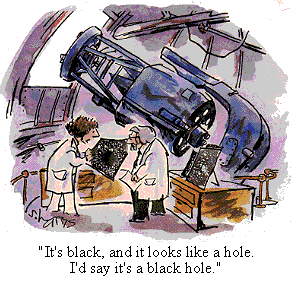
(Science
Cartoons Plus)
It is important to state that while the
fusing of hydrogen to helium is being performed in
both
low and high mass stars, high mass stars
primarily burn hydrogen through the CNO cycle
(Carbon, Nitrogen, Oxygen). Carbon acts as the
catalyst in the fusion of hydrogen and nitrogen and
oxygen absorb the protons to create helium.
If you are looking for professional help with your astronomy academic projects, just buy a research paper written by real experts.
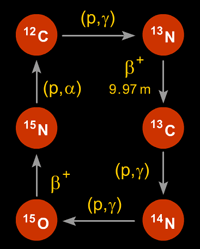 |
The main reason for this is increased
temperature and
pressure at the core than a
low mass star. The hydrogen burning shell
and helium ash core also exist in the high
mass star.
One major difference between a high mass
star and a
low mass star at this point is
the helium flash - there is no flash of
helium fusion in a high mass star. |
Here is a bit of a summary for high mass stars:
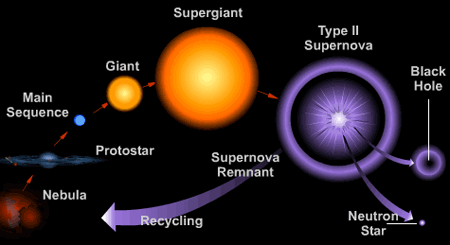
(Image credit: Brooks/Cole Thomson Learning)
The exact stages of evolutions are:
- Subgiant Branch (SGB) - hydrogen shell
burning - outer layers swell
- Red Giant Branch - helium ash core
compresses - increased hydrogen shell burning
- First Dredge Up - expanding atmosphere cools
star - stirs carbon, nitrogen and oxygen upward
- star heats up
- Core Helium Flash - continued compression
with added helium ash ignites helium - lots of
neutrinos
- Horizontal Branch - helium burning core -
hydrogen burning shell
- Pre AGB (Asymptotic Giant Branch) - outer
layers expand cooling the star - hydrogen shell
becomes dormant
- AGB - re-ignited hydrogen shell burning
(like a second Red Giant phase)
- Several stages of dredge up -
nucleosynthesis creates numerous elements (F, Ne,
Mg, Al, Li, Ne, Na)
Because a high mass star (> 4 Solar Masses) has
considerably more gravity than
low mass stars,
several shell burning stages can occur:
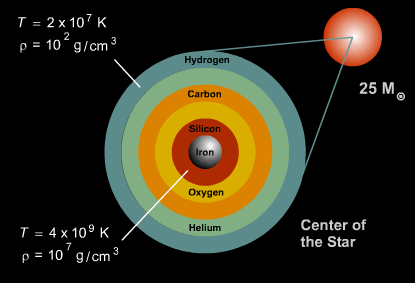
(Image credit: Brooks/Cole Thomson Learning)
But there is a limit. Iron cannot
fuse, and when it tries the end result is a highly
compacted core and intense
temperatures. The core
density is 4 x 1017 kg/m3.
This is very degenerate and cannot be compressed
further. The intense heat generated by this
compression (core bounce) blows the star apart in a
type II supernova.
 |
Click on the image to the left to view
an animation of a supernova. In this
video, two things happen: the core
collapses, explodes and begins to expand
while the star collapses (video care of
Swinburne Astronomy Online). |
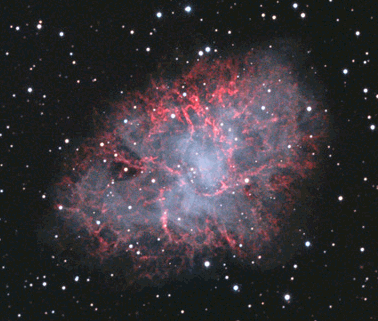
(© 2005 Russell Croman,
www.rc-astro.com)
The classic supernova remnant is the
Crab nebula.
The end result of a supernova is
three fold:
-
Heavy elements created in the
explosion
-
Intense interstellar wind
-
A neutron star (or
black hole)
stellar remnant
A white dwarf is the degenerate carbon core of a
low mass star. As such, a neutron star is the
degenerate iron core of a high mass star.

(Image credit: Brooks/Cole Thomson Learning)
Because if its composition (and energy at the
time of compression), intense magnetic energy
emanates from the neutron star, and it is spinning
rapidly (several thousand times a second).
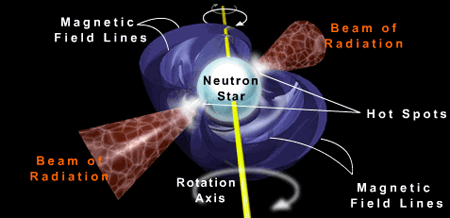
(Image credit: Brooks/Cole Thomson Learning)
This spinning neutron star is called a Pulsar. At
the heart of the Crab nebula is its stellar remnant
- a pulsar:
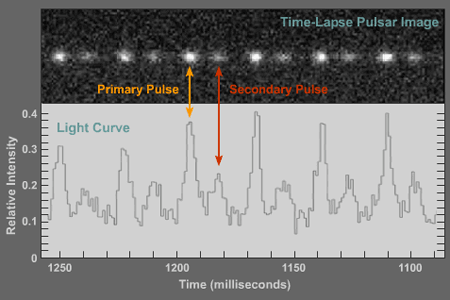
The image above demonstrates how fast a pulsar
can spin. What is also interesting is that they are
extremely accurate time keepers. A neutron star also
emits strong in the X-ray spectrum. Also, just like
a white dwarf, a neutron star can accrete material
from a companion star, but superheats it to extreme
temperature and spins faster.
If the high mass star is around 25 Solar masses,
the stellar remnant can compress much further than a
neutron star resulting in a
Black Hole.
It's important to realize that a
black hole is
not a hole in space, it's just an object with
extremely high surface gravity - but since we have
yet to "see" one (and we probably never will), we
can only infer their existence by its effect on
surrounding matter. A good friend and fellow
class-mate wrote an excellent paper going into
detail on the subject of
Black Holes, and he has
graciously allowed me to post it here. So for more
information on
Black Holes, click
Black Holes.
Core Burning Stages in a 25 Solar Mass Star:
| Fuel: |
Products: |
Temperature (K): |
Minimum Mass: |
Burning Period: |
| H |
He |
4 x 106 |
0.1 |
7 x 106 years |
| He |
C, O |
1.2 x 108 |
0.4 |
5 x 105 years |
| C |
Ne, Na, Mg, O |
6 x 108 |
4 |
600 years |
| Ne |
O, Mg |
1.2 x 109 |
~8 |
1 year |
| O |
Si, S, P |
1.5 x 109 |
~8 |
~0.5 years |
| Si |
Ni - Fe |
2.7 x 109 |
~8 |
~1 day |
Classifications of Supernova:
| Type: |
Characteristics: |
Mechanism: |
| 1a |
No H lines, strong Si II lines |
Thermonuclear runaway on white dwarf |
| 1b |
No H lines, prominent He I lines |
Core collapse of massive star stripped
of hydrogen envelope |
| 1c |
No H, Si II or He I lines |
Core collapse of massive star stripped
of helium (and hydrogen) envelope |
| II-P |
H lines - flat light curve |
Core collapse of massive star |
| II-L |
H lines - no flat light curve |
Core collapse of massive star |
Back
to Top |

